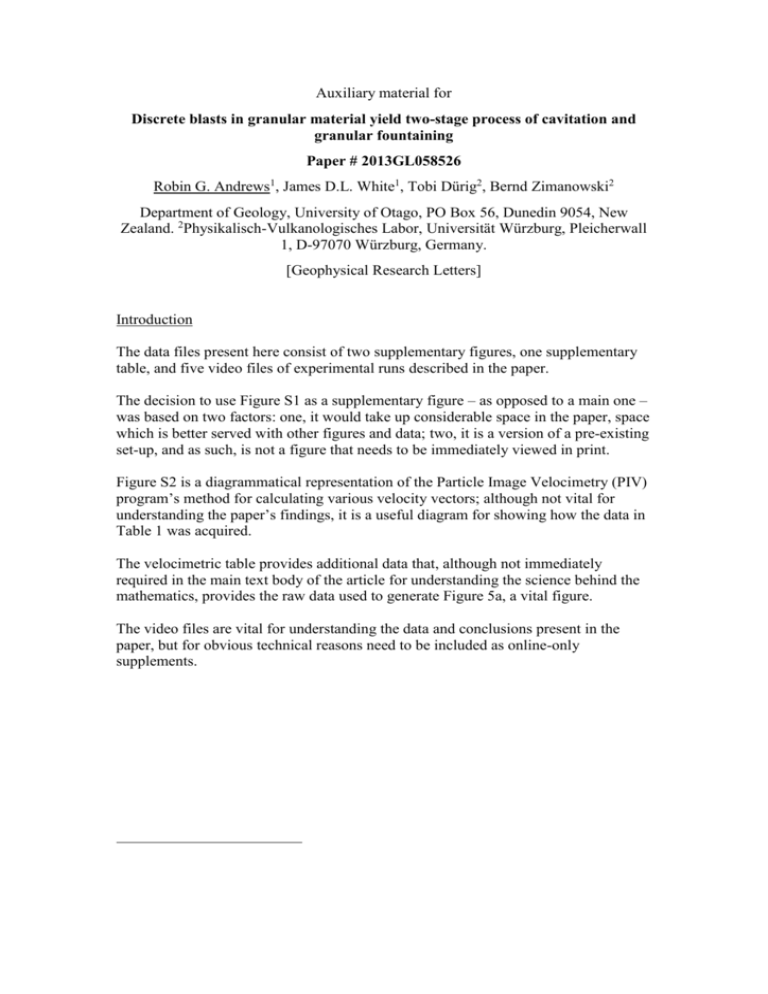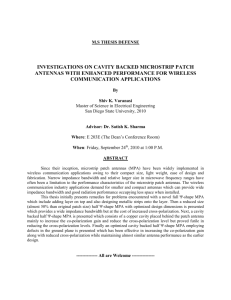Auxiliary Figure READ ME
advertisement

Auxiliary material for
Discrete blasts in granular material yield two-stage process of cavitation and
granular fountaining
Paper # 2013GL058526
Robin G. Andrews1, James D.L. White1, Tobi Dürig2, Bernd Zimanowski2
Department of Geology, University of Otago, PO Box 56, Dunedin 9054, New
Zealand. 2Physikalisch-Vulkanologisches Labor, Universität Würzburg, Pleicherwall
1, D-97070 Würzburg, Germany.
[Geophysical Research Letters]
Introduction
The data files present here consist of two supplementary figures, one supplementary
table, and five video files of experimental runs described in the paper.
The decision to use Figure S1 as a supplementary figure – as opposed to a main one –
was based on two factors: one, it would take up considerable space in the paper, space
which is better served with other figures and data; two, it is a version of a pre-existing
set-up, and as such, is not a figure that needs to be immediately viewed in print.
Figure S2 is a diagrammatical representation of the Particle Image Velocimetry (PIV)
program’s method for calculating various velocity vectors; although not vital for
understanding the paper’s findings, it is a useful diagram for showing how the data in
Table 1 was acquired.
The velocimetric table provides additional data that, although not immediately
required in the main text body of the article for understanding the science behind the
mathematics, provides the raw data used to generate Figure 5a, a vital figure.
The video files are vital for understanding the data and conclusions present in the
paper, but for obvious technical reasons need to be included as online-only
supplements.
Auxiliary Figures
(fs01) Figure S1 | A diagrammatical representation of the experimental set up
used in these runs, (after Ross et al., 2008b). The addition of the pressure sensor
inside the crucible (red circle), and the pressure sensors SIKA 1 (purple circle) & 2
(blue circle), are shown. The depth of the crucible was either “shallow” (8cm below
the surface of the stratigraphy), “medial” (16cm below the surface of the
stratigraphy), or “deep” (24cm below the surface of the stratigraphy). As scaled depth,
scaled crater diameter and optimal depth of burial calculations had not been estimated
or applied to this type of set-up or bench-scale experiment before, the depths chosen
were arbitrary, but arithmetically linear, in order to more efficiently analyse any
mathematical relationships behind them and other factors of the experimental runs.
Runs were grouped together based on the initial pressure of the compressed argon gas
(0.5 MPa, 1 MPa, 1.5 MPa, and 2 MPa), in order of either three ascending runs from
deep to shallow crucible depths, three descending runs from shallow to deep crucible
depths, or repeated runs at identical depths.
The SIKA pressure sensors used in these experiments are all ceramic element-type
sensors used for difference pressure measurements, designed for gaseous and liquid
medium engineering set-ups, with a high temperature resistance and a lowtemperature sensitivity; they are protected against polarity change. The force sensor
was a tensile and compression-type sensor.
(fs02) Figure S2 | An example of the PIV system’s velocity vector calculation
method, using Run 19. The PIV system tracked the vertical propagation of the cavity
roof bead mass and the granular fountain bead mass from their inceptions.
Instantaneous velocity measurements were calculated and averaged out over a very
short period of time (millisecond scale).
Auxiliary Table
(ts01) Table S1 | Selected experimental runs with associated velocimetric data.
This tabulated velocimetric data was used to produce Figure 5a. The velocity
measurements were determined using PIV (Particle Image Velocimetry). The runs
used for this study featured a constant crucible-based red bead mass (68g) and a
constant valve opening time (300ms). Previous runs were tests for the experimental
system; later runs featured variations to the system not applicable for this study.
Run Number: The numerically designated, chronologically ordered experimental runs.
Crucible opening depth below overlying stratigraphy: The depth at which the crucible
is present within the white bead mass. (Units: metres).
Initial Pressure: The initial pressure of the compressed argon gas. (Units: MPa).
Average velocity of cavity roof mass {α}: The PIV-determined time-averaged velocity
of the vertically propagating roof mass of the cavity, used as a proxy for the
propagating tip of the piercing gas jet. (Units: m/s).
2
Average velocity of fountaining mass {β}: The PIV-determined time-averaged
velocity of the vertically propagating fountaining mass of red beads. (Units: m/s).
α/β ratio: The ratio between the average velocity of the cavity roof mass and the
average velocity of the fountaining mass. (Units: none).
Auxiliary Videos (Dynamic Content)
(ms1) Video 1 | High-speed (originally 1000 fps) footage of Run 18, (16cm
crucible depth, 2 MPa initial pressure), depicted in Fig. 1. The dynamic
segregation, as described in the letter, is distinctly visible in this eruption with an
inwardly collapsing cavity.
(ms2) Video 2 | High-speed (originally 1000 fps) footage of Run 22, (8cm crucible
depth, 1.5 MPa initial pressure), depicted in Fig. 3. The dynamic segregation, as
described in the letter, is distinctly visible in this eruption with an outwardly
collapsing cavity.
(ms3) Video 3 | High-speed (originally 1000 fps) footage of Run 17, (8cm crucible
depth, 2 MPa initial pressure), depicted in Fig. 4. The dynamic segregation, as
described in the letter, is distinctly visible in this eruption with an outwardly
collapsing cavity.
(ms4) Video 4 | High-speed (originally 1000 fps) footage of Run 20. The dynamic
segregation, as described in the letter, is distinctly visible in this eruption with an
inwardly collapsing cavity. Initial pressure was 1.5MPa at the deepest depth, (24cm
below top layer of overlying glass bead stratigraphy).
(ms5) Video 5 | High-speed footage of Run 23. As in the previous runs, the dynamic
segregation, as described in the letter, is distinctly visible in this eruption with an
inwardly collapsing cavity. In this run, however, a paper diaphragm was placed over
the orifice within the crucible, underneath the overlying red bead mass. From this
oblique angle, the penetrating jet is visible at approximately 4s: during the gas
expansion-driven cavitation phase, the paper diaphragm is propelled into the cavity by
the centralised argon jet, along with a minority of the red bead mass. At 5.5s, the
paper diaphragm is blasted back up into the now-collapsing cavity by the fountaining
effect.
Ross, P-S., White, J.D.L., Zimanowski, B. & Büttner, R. (2008b). Multiphase flow
above explosion sites in debris-filled volcanic vents: Insights from analogue
experiments. Journal of Volcanology and Geothermal Research 178, 104-112. doi:
10.1016/j.jvolgeores.2008.01.013
3






